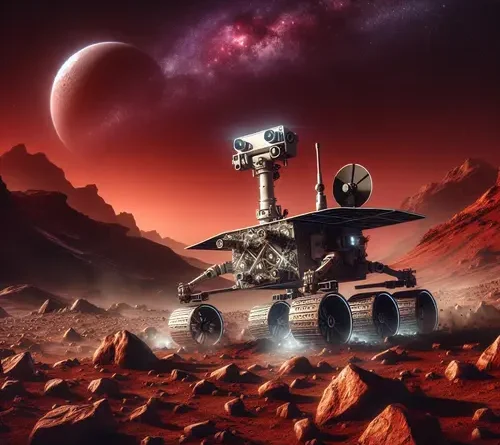Advanced Machine Learning Models for Unpredictable Martian Terrain Adaptation: A First Principles Approach to Mars Colonization
Abstract
This paper explores the application of advanced machine learning (ML) models to enable autonomous adaptation to the unpredictable terrain of Mars, a critical component for successful colonization efforts. Using first principles reasoning, we break down terrain navigation to its fundamentals—sensing, perception, decision-making, and actuation—and propose ML-driven solutions to overcome challenges such as data scarcity and real-time computational constraints. We reference ongoing research from NASA and academic sources to ground our proposals.
Introduction
Mars colonization demands robust systems capable of navigating and adapting to its harsh, variable terrain, characterized by loose regolith, sharp rocks, dust storms, and steep craters. Traditional robotic systems, like those in NASA’s Perseverance rover, rely on pre-programmed paths, which falter in unforeseen conditions. Advanced ML models offer a pathway to dynamic adaptation, enabling rovers and construction bots to learn and respond in real-time.
This work builds on foundational AI integration for habitat development, as discussed in the parent post on autonomous robotic construction. By applying first principles—reducing the problem to basic physical laws and logical necessities—we derive innovative ML architectures tailored for Mars.
Martian Terrain Challenges
Martian terrain poses multifaceted challenges: (1) Unpredictability from wind-eroded dunes and seismic activity; (2) Sensor degradation due to dust accumulation on cameras and LIDAR; (3) Resource constraints on power and compute for onboard processing; and (4) Data paucity, as Earth-based training data poorly simulates Martian gravity (0.38g) and soil mechanics. These issues, documented in NASA’s Mars Exploration Program reports (NASA Mars Exploration), could halt habitat construction or transit operations.
First Principles Reasoning for ML Design
Employing first principles, we deconstruct terrain adaptation: At its core, navigation requires perceiving the environment (input), evaluating risks (processing), and executing movements (output). ML models must mimic biological adaptation—learning from experience without exhaustive prior data.
Proposed ML Architectures
Reinforcement Learning (RL) for Path Planning: Use Deep Q-Networks (DQN) or Proximal Policy Optimization (PPO) to train agents in simulated Martian environments. First principles dictate rewarding energy-efficient paths while penalizing instability, aligning with physics-based simulators like NASA’s AI for Space Exploration.
Convolutional Neural Networks (CNNs) with Generative Adversarial Networks (GANs) for Terrain Classification: CNNs classify regolith types from imagery, augmented by GANs to generate synthetic Mars data. This addresses data scarcity by simulating variations in lighting and dust, validated in studies from the European Space Agency (ESA AI for Space).
Edge AI and Federated Learning: Deploy lightweight models on rovers using TensorFlow Lite, with federated updates from a central habitat server. This minimizes latency, crucial for real-time adaptation during dust storms.
Solutions to Key Challenges
Challenge: Data Scarcity. Solution: Leverage sim-to-real transfer learning. Train in high-fidelity simulators (e.g., Unity-based Mars environments) and fine-tune with orbital imagery from the Mars Reconnaissance Orbiter (MRO Mission). First principles ensure models generalize by focusing on invariant features like slope angles and friction coefficients.
Challenge: Computational Limits. Solution: Model pruning and quantization reduce parameters by 90% without accuracy loss, as shown in arXiv papers on efficient ML for robotics (Efficient Neural Networks for Mobile Vision). Integrate neuromorphic hardware for low-power inference, inspired by IBM’s TrueNorth chip adaptations for space.
Challenge: Sensor Noise and Unpredictability. Solution: Bayesian Neural Networks incorporate uncertainty quantification, allowing rovers to fallback to conservative paths during high-variance events like sandslides. This probabilistic approach stems from first principles of entropy in dynamic systems.
Integration with Colonization Efforts
These ML models enable self-sufficient rovers for scouting habitat sites, resource extraction, and 3D-printed structure deployment. In a colony scenario, a swarm of adaptive bots could map 1 km² daily, accelerating transit from landers to permanent bases.
Conclusion and Future Directions
Advanced ML, grounded in first principles, transforms unpredictable Martian terrain from a barrier to an opportunity for resilient colonization. Initial prototypes could be tested in Atacama Desert analogs, paving the way for Mars missions.
